This Document is available as a Acrobat
PDF file optimised for printing, just click here.
Experimental varification
(PROOF) of the ideas described below can be found
here!
© R. Stankey, Orange, NSW 2800 Australia
|
An Analysis of Lenz's law
"The direction of an induced current
is such as
to oppose the cause producing
it"
by
Richard Stankey
B.Sc.(Hons) Dip.Ed. M.Sc.
October 1995
Narrandera NSW 2700
Australia
|
Introduction
Lenz's Law is a simplification of Faraday's law and unfortunately
can be easily misinterpreted resulting in false conclusions being
drawn about various interactions between permanent magnets and
non-ferrous conductors.
It is the intension of this paper to clarify this situation and
reveal the potential benefits that can be obtained from the correct
interpretation of these laws.
To start with, lets establish some conventions based on these
laws. This will be followed by a series of simple experiments which
can be repeated by anyone and that will clarify any confusion.
|

|
For a conductor carrying a current, B is the direction of
an external magnetic field, V is the direction in which the
conductor is pushed, the direction of motion, and F is the
direction in which the electric current (positive charge) is
induced. This is true for any conductor in relative motion
perpendicular to the direction of any magnetic field.
|
 Any
electric current has associated with it, a magnetic field. This is
defined by the Right Hand Grip Rule. Where I is the direction of the
electric current (positive charge),
. is where the magnetic flux
comes out of the page and x is where it disappears into the
page.
Any
electric current has associated with it, a magnetic field. This is
defined by the Right Hand Grip Rule. Where I is the direction of the
electric current (positive charge),
. is where the magnetic flux
comes out of the page and x is where it disappears into the
page.
 In diagrams
showing magnetic flux lines, solid lines indicate a permanent
magnetic field, while grey lines represent induced flux lines.
In diagrams
showing magnetic flux lines, solid lines indicate a permanent
magnetic field, while grey lines represent induced flux lines.
When considering standard magnets, attraction results when unlike
poles are placed near each other, that is the flux lines are parallel
and oppose each other. While like poles repel because the flux lines
are parallel and in the same direction.
 These
diagrams are slightly unconventional as they show the flux lines of
each magnet when, or just before, an interaction between two magnets
takes place, rather then the more conventional flux pattern which
results from the interaction of two magnets and which can be easily
observed using iron filings and two bar magnets. These diagrams
clearly show that opposing flux lines result in attraction, while
unidirectional flux lines from different sources result in
repulsion.
These
diagrams are slightly unconventional as they show the flux lines of
each magnet when, or just before, an interaction between two magnets
takes place, rather then the more conventional flux pattern which
results from the interaction of two magnets and which can be easily
observed using iron filings and two bar magnets. These diagrams
clearly show that opposing flux lines result in attraction, while
unidirectional flux lines from different sources result in
repulsion.
 Remembering
that an electric current is only induced when a conductor is placed
in a changing magnetic field, or when there is relative motion
between a conductor and a magnetic field (moving at right angles to
each other).
Remembering
that an electric current is only induced when a conductor is placed
in a changing magnetic field, or when there is relative motion
between a conductor and a magnetic field (moving at right angles to
each other).
Let us now consider Lenz's law which states that:
"The direction of an induced current is
such as to oppose the
cause producing it"
This law is sufficiently vague to allow for several
interpretations, including the following:
1) That the induced magnetic field opposes the permanent magnetic
field. This would result in an attraction between the conductor and
the permanent magnet.
2) That the forces which result from the interaction of the
magnetic fields oppose each other. This would mean that the conductor
and the magnet would repel each other. It would also mean that the
permanent and induced magnetic fields are unidirectional.
In the past it has been difficult to resolve this apparent
confusion experimentally, as powerful magnets where too heavy,
expensive and difficult to obtain, in order to carry out an
experiment and "feel" the forces involved. However, with the recent
(last 10 years) discovery of Neodymium, Boron, Iron magnets and their
cheap and plentiful supply (last 2 years), it is now very easy to
resolve this dilemma. As these magnets are 30 times more powerful
then traditional ferrite magnets, it is now very easy to analyse
permanent and induced magnetic forces.
Consider a flat conductor, such as a piece of aluminium, and a
cylindrical magnet with its north and south poles located on its flat
surfaces. If the magnet is moved along and just above the conductor,
then the magnet will induce a current in the conductor, this current
produces its own magnetic field which will interact with the
permanent magnetic field resulting in forces of attraction and
repulsion.
There are three fundamental ways in which the magnet can be held
while moving it along the conductor. We shall consider each case, the
associated currents, magnetic fields and forces separately in order
to gain a better understanding of the concepts involved and to
clarify the confusion caused by Lenz's law.
Case 1: The cylindrical magnet is
placed North (or South) face down, that is flat side down. It is than
moved along the conductor, while being held just above its surface.
If the magnet is moved left to right, then the lines of flux leave
the magnet at right angles and intersect the conductor inducing a
current which will flow towards the operator. Using the Right Hand
Grip Rule, this current will induce a magnetic field which will cause
opposing flux lines at the front or leading edge of the magnet, which
in turn will result in an attractive force. While near the trailing
or rear end of the magnet, the flux lines will approach
unidirectionality and hence a force of repulsion will result. This
visualisation reveals that Lenz's law is an oversimplification, as
both forces of attraction and repulsion are involved.
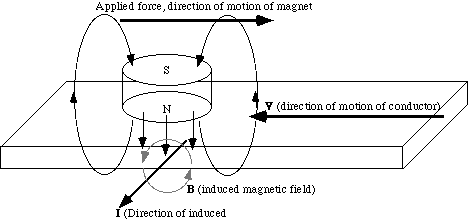
It is important to realise that the current is induced in the
conductor and not in the magnet, therefore it is the relative
direction of motion of the conductor which must be considered. To
help visualise the induced current, study the following
animation:
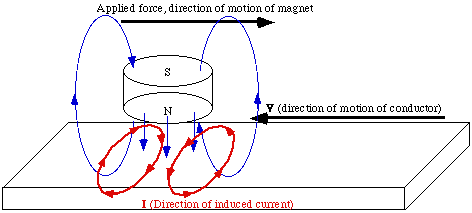
The induced current will induce its own magnetic field,
represented in yellow/green below:
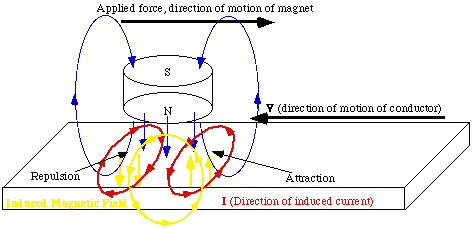
From this diagram it can be seen that at the leading edge of the
magnet, there is an attraction between it and the metal, while there
is a similar repulsive force at the trailing edge of the magnet.
The above animation can be represented statically as shown below.
An opposing (attracting pole) will form on the surface of the
conductor near the leading edge of the magnet, relative to the
direction of motion of the conductor, as shown in the diagram
below.
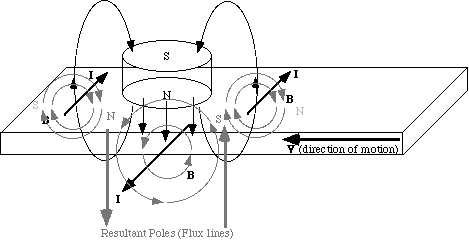
It is important to note that if the magnet were placed upside down
(South face down), all flux lines, poles and directions of currents
would be reversed, but the resulting forces would be the same, that
is attraction at the leading edge and repulsion at the trailing
edge.
There are two more cases to consider, in each of these, the magnet
has been rotated by 90š so as to change the direction of the flux
lines. The resultant induced currents and associated flux lines are
depicted and discussed below.
Case 2: A cylindrical magnet is
placed on its side and moved along the conductor as shown, while
being held just above the surface of that conductor. It is important
to realise that only a small proportion of the magnetic flux actually
intersects with the conductor. These flux lines still induce a
current which has an associated "induced" magnetic flux. This can be
seen in the diagram below.
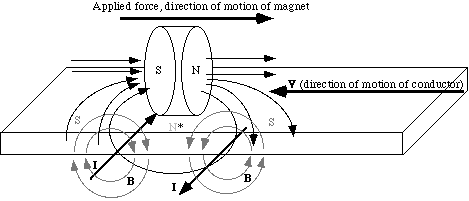
Of the three induced poles, the N* is in an area where the magnet
has no or very low flux density hence the induced N* pole will have
no affect on the resulting forces experienced by the magnet held in
this position and moved along the conductor. The two induced S
(south) poles, have the affect of attracting the leading edge of the
magnet and repelling the trailing edge of the magnet.
The opposing permanent and induced flux lines at the leading N
(north) edge or face of the magnet also indicate an attraction, as
does the presence of the induced S (south) and permanent N (north)
poles. While at the rear (southern) end of the magnet, the induced S
(south) pole and parallel flux lines which run in the same direction,
indicate a repulsive force.
Case 3: The magnet in
case 2 is spun around by 90š and then moved along the conductor as in
the previous two cases. The resultant interactions are described in
the following diagram.
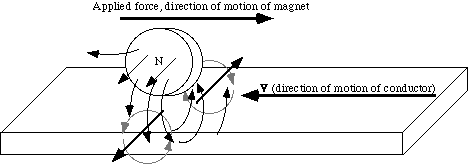
Again it can be seen that there is an attraction at the leading
edge of the magnet and a repulsion at the trailing edge. However, as
only a very small proportion of the flux lines will interact with the
conductor, the resulting forces from this interaction are minimal, as
an experiment will confirm.
If the three cases discussed above are correct, then a magnet or
other magnetic dipole should rotate when positioned near a moving
conductor. The direction of motion of the magnet would be the same as
 that of a
wheel or cog touching the conductor. In this case (the diagram on the
left), the conductor is an Aluminium rod which can be freely rotated.
The bar magnet above consists of two cylindrical magnets, pivoted in
the middle on a sewing needle, this needle is suspended in a loop of
insulated copper wire. As the Aluminium roller is rotated, the
magnets start to rotate in the predicted direction. This confirms
experimentally that the above described theory is in fact correct.
This experiment can be easily reproduced to verify my claims and
explanations. The observations, realisations and explanations offered
here seem to indicate that it may be possible to create a self
perpetuating device which could potentially yield electrical energy
from the interaction of permanent and electric fields. However, this
would appear to violate the first and second law of
thermodynamics.
that of a
wheel or cog touching the conductor. In this case (the diagram on the
left), the conductor is an Aluminium rod which can be freely rotated.
The bar magnet above consists of two cylindrical magnets, pivoted in
the middle on a sewing needle, this needle is suspended in a loop of
insulated copper wire. As the Aluminium roller is rotated, the
magnets start to rotate in the predicted direction. This confirms
experimentally that the above described theory is in fact correct.
This experiment can be easily reproduced to verify my claims and
explanations. The observations, realisations and explanations offered
here seem to indicate that it may be possible to create a self
perpetuating device which could potentially yield electrical energy
from the interaction of permanent and electric fields. However, this
would appear to violate the first and second law of
thermodynamics.
Magnetodynamics
The term thermodynamics means and relates to devices (engines)
which use heat (Thermo) to generate motion (Dynamics). If it were
possible to create a permanent and induced magnet motor such as
suggested by the above theory, then the first two laws of
thermodynamics need to be considered. The first law of thermodynamics
states:
"Energy can not be created or
destroyed"
Scientists have proved over the years that this law does not apply
to every form of energy generation. For example in modern nuclear
reactors, we break up heavy atoms to form lighter ones with a slight
overall loss in mass, where the lost mass can be roughly equated to
the energy liberated using the relationship E = mc2. A
similar mass to energy conversion is used in thermonuclear bombs, and
in the continuous nuclear reaction which fires our Sun, here light
atoms combine to form heavier ones with a slight loss of mass and a
resulting conversion to energy.
Scientists have also shown that it is possible to convert energy
into matter. It appears that this only occurs during supernova
explosions, where there is sufficient energy released to created
atoms heavier than iron.
To explain this apparent braking of the laws of physics some
people have claimed that matter and energy are the same thing, that
is that energy is a form of matter and visa versa. However, energy
can be used to do work, matter can not!
It is clear from this that a precedent has been set for braking or
defying the laws of thermodynamics. Accordingly it may be possible
that there are some procedures or devices which defy the second law
of thermodynamics, which states that:
"An engine cannot yield more than 100%
output for a given input,
and usually yields much
less"
As pointed out previously, conventional engines are Thermodynamic
devices and require the use of heat to generate motion. Previous
inventors of magnetically driven engines claim that the motion
generated does not involve or require the use of heat (Thermo) but
instead the interactions of magnetic forces. Hence it stands to
reason that the laws of thermodynamics my not apply to these devices.
Further, a new law, as jet undefined, may apply to the type of motion
which results from the interaction of magnetic forces, and therefore
should be called the law of Magnetodynamics.
It may well turn out that these devices comply with the laws of
thermodynamics (even though they do not necessarily apply) upon the
completion of a full scientific investigation of this apparent
anomaly.
It should be noted that reverse cycle air conditioners appear to
defy this law of thermodynamics, because devices commonly known as
heat pumps, produce 3 units of heat energy for every unit of
electrical energy used.

 In diagrams
showing magnetic flux lines, solid lines indicate a permanent
magnetic field, while grey lines represent induced flux lines.
In diagrams
showing magnetic flux lines, solid lines indicate a permanent
magnetic field, while grey lines represent induced flux lines. These
diagrams are slightly unconventional as they show the flux lines of
each magnet when, or just before, an interaction between two magnets
takes place, rather then the more conventional flux pattern which
results from the interaction of two magnets and which can be easily
observed using iron filings and two bar magnets. These diagrams
clearly show that opposing flux lines result in attraction, while
unidirectional flux lines from different sources result in
repulsion.
These
diagrams are slightly unconventional as they show the flux lines of
each magnet when, or just before, an interaction between two magnets
takes place, rather then the more conventional flux pattern which
results from the interaction of two magnets and which can be easily
observed using iron filings and two bar magnets. These diagrams
clearly show that opposing flux lines result in attraction, while
unidirectional flux lines from different sources result in
repulsion. Remembering
that an electric current is only induced when a conductor is placed
in a changing magnetic field, or when there is relative motion
between a conductor and a magnetic field (moving at right angles to
each other).
Remembering
that an electric current is only induced when a conductor is placed
in a changing magnetic field, or when there is relative motion
between a conductor and a magnetic field (moving at right angles to
each other).





 that of a
wheel or cog touching the conductor. In this case (the diagram on the
left), the conductor is an Aluminium rod which can be freely rotated.
The bar magnet above consists of two cylindrical magnets, pivoted in
the middle on a sewing needle, this needle is suspended in a loop of
insulated copper wire. As the Aluminium roller is rotated, the
magnets start to rotate in the predicted direction. This confirms
experimentally that the above described theory is in fact correct.
This experiment can be easily reproduced to verify my claims and
explanations. The observations, realisations and explanations offered
here seem to indicate that it may be possible to create a self
perpetuating device which could potentially yield electrical energy
from the interaction of permanent and electric fields. However, this
would appear to violate the first and second law of
thermodynamics.
that of a
wheel or cog touching the conductor. In this case (the diagram on the
left), the conductor is an Aluminium rod which can be freely rotated.
The bar magnet above consists of two cylindrical magnets, pivoted in
the middle on a sewing needle, this needle is suspended in a loop of
insulated copper wire. As the Aluminium roller is rotated, the
magnets start to rotate in the predicted direction. This confirms
experimentally that the above described theory is in fact correct.
This experiment can be easily reproduced to verify my claims and
explanations. The observations, realisations and explanations offered
here seem to indicate that it may be possible to create a self
perpetuating device which could potentially yield electrical energy
from the interaction of permanent and electric fields. However, this
would appear to violate the first and second law of
thermodynamics.